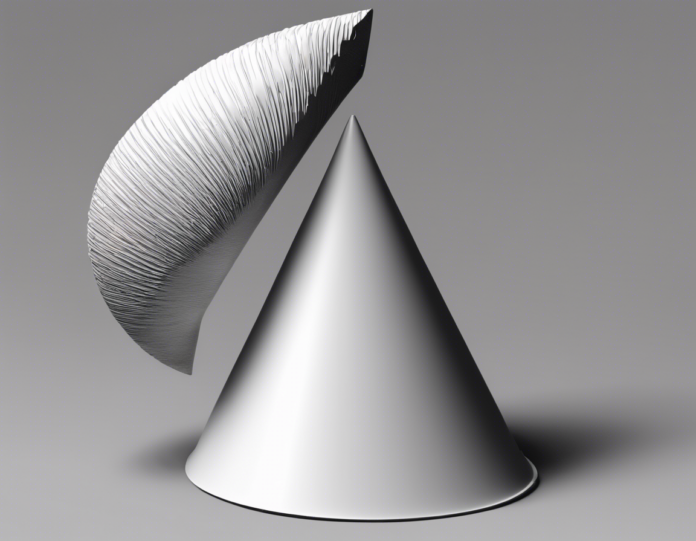A solid right circular cone is a three-dimensional shape that consists of a circular base, a point called the apex (or vertex), and a curved surface connecting the base to the apex. The axis of the cone is the straight line passing through the apex and the center of the base, perpendicular to the base. In this article, we will delve into the definition, properties, and formulas associated with solid right circular cones.
Definition and Components of a Solid Right Circular Cone
A solid right circular cone is uniquely defined by its radius (denoted as r), height (h), slant height (l), and surface area (A) and volume (V). The radius is the distance from the center of the base to the edge, the height is the distance from the base to the apex along the axis, and the slant height is the distance between the apex and any point on the circumference of the base.
Properties of a Solid Right Circular Cone
1. Surface Area of a Cone:
The surface area (A) of a cone can be calculated using the formula:
[ A = \pi r \left( r + l \right) ]
where π represents the mathematical constant pi (approximately 3.14159).
2. Volume of a Cone:
The volume (V) of a cone is given by the formula:
[ V = \frac{1}{3} \pi r^2 h ]
3. Slant Height of a Cone:
The slant height (l) of a cone can be found using the Pythagorean theorem in relation to the height and radius:
[ l = \sqrt{r^2 + h^2} ]
4. Lateral Surface Area of a Cone:
The lateral surface area of a cone (LA) refers to the area of the curved surface excluding the base, and it can be calculated as:
[ LA = \pi r l ]
Formulas and Theorems Related to Solid Right Circular Cones
- The Pythagorean Theorem in Cones:
In a right triangle formed by the slant height, radius, and height of a cone, the Pythagorean theorem holds true: ( r^2 + h^2 = l^2 ).
- Similarity of Cones:
Given two cones with equal apex angles, their volumes are proportional to the cubes of their radii.
- Cone-Cylinder Relationship:
A cone can be seen as precisely one-third of a cylinder with the same base and height.
Surface Area and Volume Applications
The surface area and volume of a cone play crucial roles in various practical applications and industries, including:
- Engineering: Cones are commonly found in engineering applications such as traffic cones, ice cream cones, and conical roofs.
- Architecture: The shape of a cone is frequently seen in the design of towers, roofs, and skylights.
- Manufacturing: The calculation of surface area and volume in conical objects is vital in manufacturing processes for quality control and materials estimation.
Frequently Asked Questions (FAQs) about Solid Right Circular Cones
Q1: What is the difference between a cone and a pyramid?
A cone has a circular base and a curved surface extending to a single point (apex), while a pyramid has a polygonal base and flat faces that converge to a vertex.
Q2: How do you find the slant height of a cone?
The slant height of a cone can be calculated using the Pythagorean theorem in relation to the radius and height: ( l = \sqrt{r^2 + h^2} ).
Q3: What is the lateral surface area of a cone?
The lateral surface area of a cone refers to the area of the curved surface excluding the base and can be calculated as ( LA = \pi r l ).
Q4: Can a cone have a negative volume?
No, the volume of a solid right circular cone is always a positive value since volume represents the amount of space enclosed by the cone.
Q5: How does the height of a cone affect its volume?
The volume of a cone is directly proportional to the height; as the height increases, the volume of the cone also increases.
Q6: Is a cone considered a polyhedron?
No, a cone is not a polyhedron since it does not consist of flat faces. Instead, it has a curved surface extending from the base to the apex.
Q7: Can a cone be considered a cylinder?
A cone can be seen as precisely one-third of a cylinder with the same base and height. However, they are distinct geometric shapes due to their varying structures.
Q8: What are some real-life examples of cones?
Examples of cones in everyday life include traffic cones, ice cream cones, party hats, and volcano shapes.
Q9: How does the slant height relate to the diameter of the base in a cone?
The slant height is related to the diameter of the base through the Pythagorean theorem: ( l^2 = r^2 + h^2 ), where ( r ) is the radius and ( h ) is the height.
Q10: Are there any applications of cones in mathematics beyond geometry?
Cones are also utilized in calculus, particularly in the concept of surface area in 3D space and the various applications of integrals involving conical shapes.
In conclusion, solid right circular cones possess unique properties and formulas that make them essential elements in geometry and various fields of study. Understanding the components, surface area, and volume of cones opens up a realm of applications in real-world scenarios, providing practical insights into the significance of these geometric shapes.

